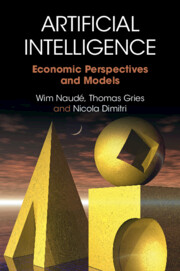Refine search
Actions for selected content:
48558 results in Computer Science
Guiding prevention initiatives by applying network analysis to systems maps of adverse childhood experiences and adolescent suicide
-
- Journal:
- Network Science / Volume 12 / Issue 3 / September 2024
- Published online by Cambridge University Press:
- 24 May 2024, pp. 234-260
-
- Article
-
- You have access
- Open access
- HTML
- Export citation
A review for the Journal of Functional Programming of Sandy Maguire, Algebra-Driven Design (Leanpub, 2020).
-
- Journal:
- Journal of Functional Programming / Volume 34 / 2024
- Published online by Cambridge University Press:
- 24 May 2024, e6
-
- Article
-
- You have access
- Open access
- HTML
- Export citation

Artificial Intelligence
- Economic Perspectives and Models
-
- Published online:
- 23 May 2024
- Print publication:
- 30 May 2024
Imagining the future – rejecting the present: Future thought and defensive discourse strategies in Russian society during wartime
- Part of
-
- Journal:
- Memory, Mind & Media / Volume 3 / 2024
- Published online by Cambridge University Press:
- 23 May 2024, e14
-
- Article
-
- You have access
- Open access
- HTML
- Export citation
Noise sensitivity of the minimum spanning tree of the complete graph
- Part of
-
- Journal:
- Combinatorics, Probability and Computing / Volume 33 / Issue 6 / November 2024
- Published online by Cambridge University Press:
- 23 May 2024, pp. 708-723
-
- Article
-
- You have access
- Open access
- HTML
- Export citation
Quantile-based information generating functions and their properties and uses
- Part of
-
- Journal:
- Probability in the Engineering and Informational Sciences / Volume 38 / Issue 4 / October 2024
- Published online by Cambridge University Press:
- 22 May 2024, pp. 733-751
-
- Article
-
- You have access
- Open access
- HTML
- Export citation
STRONG COMPLETENESS OF A FIRST-ORDER TEMPORAL LOGIC FOR REAL TIME
- Part of
-
- Journal:
- The Review of Symbolic Logic / Volume 18 / Issue 2 / June 2025
- Published online by Cambridge University Press:
- 22 May 2024, pp. 527-544
- Print publication:
- June 2025
-
- Article
-
- You have access
- Open access
- HTML
- Export citation
Electro-mechanical modeling and identification of the UR5 e-series robot
-
- Article
-
- You have access
- Open access
- HTML
- Export citation
The impact of high-immersion virtual reality on EFL learners’ foreign language speaking anxiety: A mixed-method approach
-
- Article
-
- You have access
- Open access
- HTML
- Export citation
Index
-
- Book:
- Linear Algebra for Data Science, Machine Learning, and Signal Processing
- Published online:
- 01 November 2024
- Print publication:
- 16 May 2024, pp 423-431
-
- Chapter
- Export citation
7 - Low-Rank Approximation and Multidimensional Scaling
-
- Book:
- Linear Algebra for Data Science, Machine Learning, and Signal Processing
- Published online:
- 01 November 2024
- Print publication:
- 16 May 2024, pp 238-282
-
- Chapter
- Export citation
Contents
-
- Book:
- Linear Algebra for Data Science, Machine Learning, and Signal Processing
- Published online:
- 01 November 2024
- Print publication:
- 16 May 2024, pp vii-xiv
-
- Chapter
- Export citation
References
-
- Book:
- Linear Algebra for Data Science, Machine Learning, and Signal Processing
- Published online:
- 01 November 2024
- Print publication:
- 16 May 2024, pp 405-422
-
- Chapter
- Export citation






